steering Oldsmobile Aurora 1998 Owner's Manuals
[x] Cancel search | Manufacturer: OLDSMOBILE, Model Year: 1998, Model line: Aurora, Model: Oldsmobile Aurora 1998Pages: 380, PDF Size: 19.75 MB
Page 35 of 380
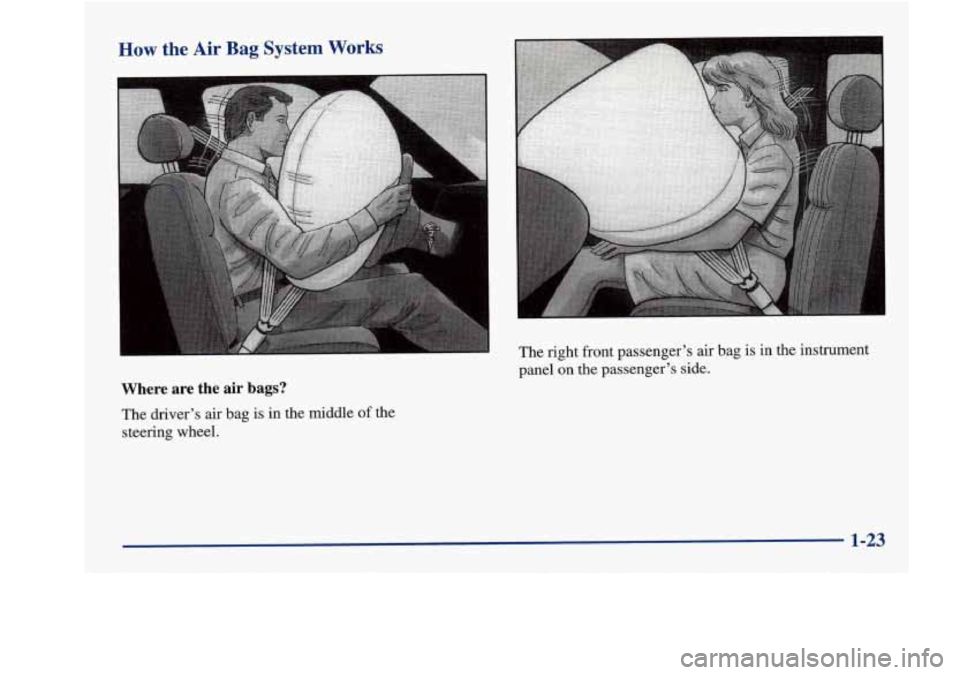
How the Air Bag System Works
I
Where are the air bags?
The driver’s air bag is in the middle of the
steering wheel. The right front
passenger’s air bag is
in the instrument
panel on the passenger’s side.
1-23
Page 36 of 380
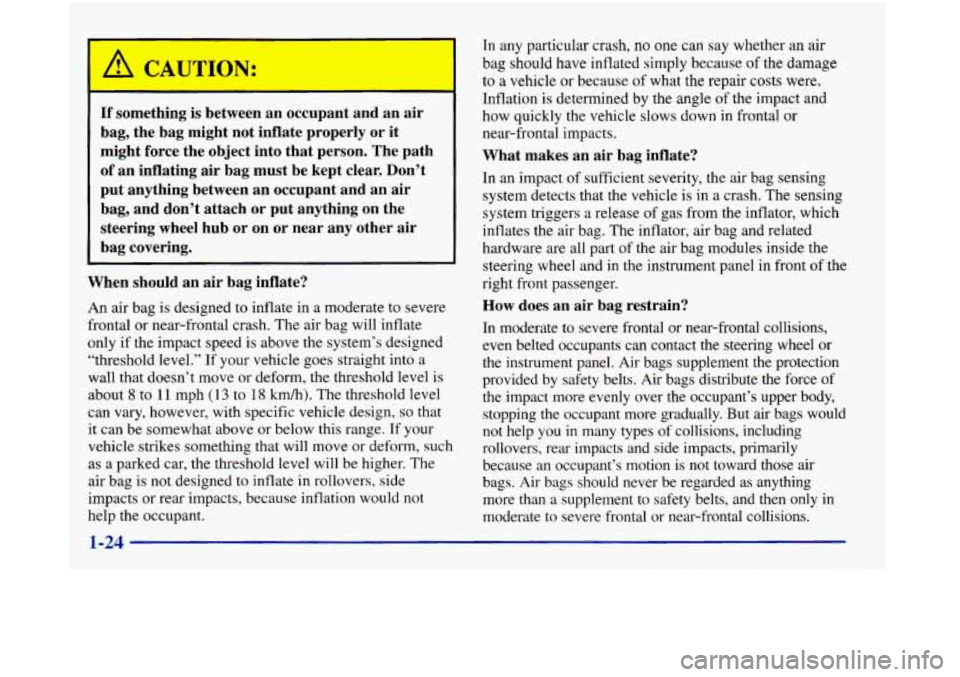
If something is between an occupant and an air
bag, the bag might not inflate properly or it
might force the object into that person. The path
of an inflating air bag must be kept clear. Don’t
put anything between an occupant and an air
bag, and don’t attach or put anything on the
steering wheel hub or on or near any other air
bag covering.
When should an air bag inflate?
An air bag is designed to inflate in a moderate to severe
frontal or near-frontal crash. The air bag will inflate
only
if the impact speed is above the system’s designed
“threshold level.” If your vehicle goes straight into a
wall that doesn’t move or deform, the threshold level
is
about 8 to 11 mph (13 to 18 km/h). The threshold level
can vary, however, with specific vehicle design,
so that
it can be somewhat above or below this range. If your
vehicle strikes something that will move or deform, such
as a parked car, the threshold level will be higher. The
air bag is not designed to inflate
in rollovers, side
impacts or rear impacts, because inflation would not
help the occupant. In
any particular crash,
no one can say whether an air
bag should have inflated simply because of the damage
to
a vehicle or because of what the repair costs were.
Inflation
is determined by the angle of the impact and
how quickly the vehicle slows down
in frontal or
near-frontal impacts.
What makes an air bag inflate?
In an impact of sufficient severity, the air bag sensing
system detects that the vehicle
is in a crash. The sensing
system triggers a release of gas from the inflator, which
inflates the air bag. The inflator, air bag and related
hardware are all part
of the air bag modules inside the
steering wheel and in the instrument panel in front of the
right front passenger.
How does an air bag restrain?
In moderate to severe frontal or near-frontal collisions,
even belted occupants can contact the steering wheel or
the instrument panel. Air bags supplement the protection
provided by safety belts.
Air bags distribute the force of
the impact more evenly over the occupant’s upper body,
stopping the occupant more gradually. But
air bags would
not help you in many types of collisions, including
rollovers, rear impacts and side impacts, primarily
because an occupant’s motion
is not toward those air
bags.
Air bags should never be regarded as anything
more than a supplement to safety belts, and then only in
moderate to severe frontal or near-frontal collisions.
I
1-24
Page 37 of 380
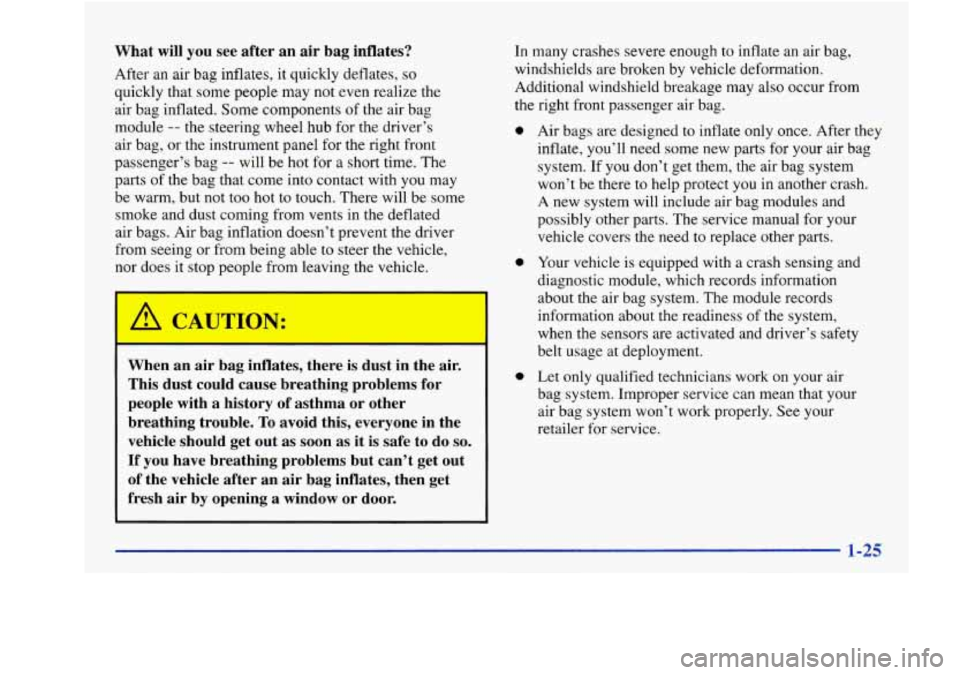
What will you see after an air bag inflates?
After an air bag inflates, it quickly deflates, so
quickly that some people may not even realize the
air bag inflated. Some components
of the air bag
module
-- the steering wheel hub for the driver’s
air bag, or the instrument panel for the right front
passenger’s bag
-- will be hot for a short time. The
parts of the bag that come into contact with you may
be warm, but not too hot to touch. There will be some
smoke and dust coming from vents in the deflated
air bags. Air bag inflation doesn’t prevent the driver
from seeing or from being able to steer the vehicle,
nor does it stop people from leaving the vehicle.
I
When an air bag inflates, there is dust in the air.
This dust could cause breathing problems for
people with a history
of asthma or other
, breathing trouble. To avoid this, everyone in the
vehicle should get out as soon as it is safe to
do so.
If you have breathing problems but can’t get out
of the vehicle after an air bag inflates, then get
fresh air by opening a window or door.
In many crashes severe enough to inflate an air bag,
windshields are broken by vehicle deformation.
Additional windshield breakage may
also occur from
the right front passenger air bag.
Air bags are designed to inflate only once. After they,
inflate, you’ll need some new parts for your air bag
system.
If you don’t get them, the air bag system
won’t be there to help protect you in another crash.
A new system will include air bag modules and
possibly other parts. The service manual for your
vehicle covers the need to replace other parts.
Your vehicle is equipped with a crash sensing and
diagnostic module, which records information
about the air bag system. The module records
information about the readiness of the system,
when the sensors
are activated and driver’s safety
belt usage at deployment.
Let only qualified technicians work on your air
bag system. Improper service can mean that your
air bag system won’t work properly. See your
retailer for service.
Page 38 of 380
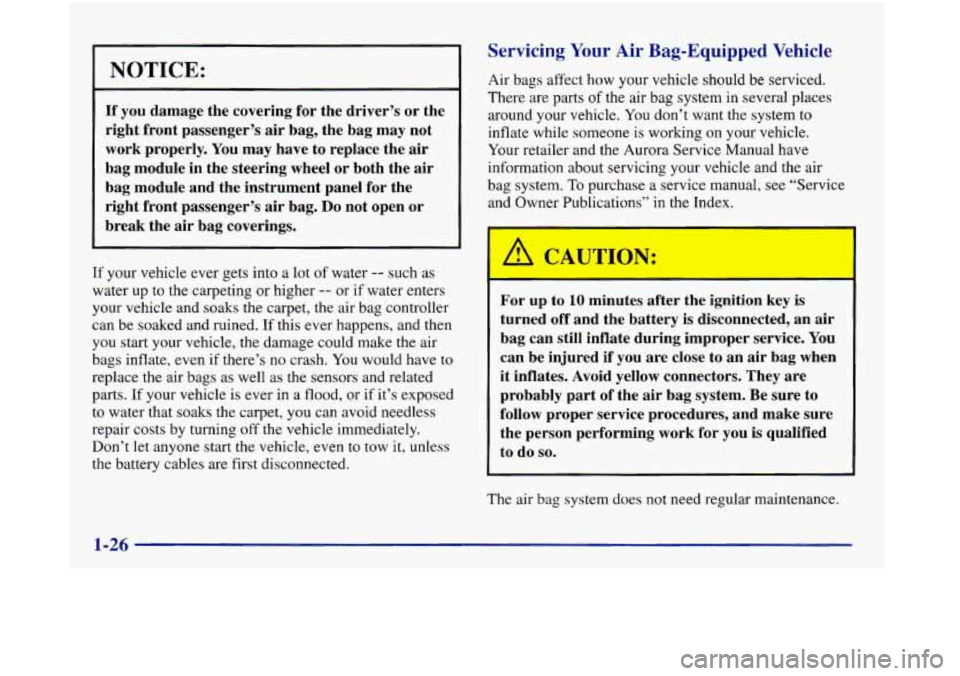
NOTICE:
If you damage the covering for the driver’s or the
right front passenger’s air bag, the bag may not
work properly. You may have to replace the air
bag module in the steering wheel or both the air
bag module and the instrument panel for the
right front passenger’s air bag.
Do not open or
break the air bag coverings.
Servicing Your Air Bag-Equipped Vehicle
Air bags affect how your vehicle should be serviced.
There are parts of the air bag system in several places
around your vehicle.
You don’t want the system to
inflate while someone is working
on your vehicle.
Your retailer and the Aurora Service Manual have
information about servicing your vehicle and the air
bag system.
To purchase a service manual, see “Service
and Owner Publications” in the Index.
I I I
If your vehicle ever gets into a lot of water -- such as
water up to the carpeting or higher
-- or if water enters
your vehicle and soaks the carpet, the air bag controller
can be soaked and ruined. If this ever happens, and then
you start your vehicle,
the damage could make the air
bags inflate, even if there’s no crash. You would have to
replace
the air bags as well as the sensors and related
parts. If your vehicle
is ever in a flood, or if it’s exposed
to water that soaks the carpet, you can avoid needless
repair costs by turning
off the vehicle immediately.
Don’t let anyone start the vehicle, even to tow it, unless
the battery cables are first disconnected.
I
~ For up to 10 minutes after the ignition key is
~ turned off and the battery is disconnected, an air
bag can still inflate during improper service. You
can be injured if you are close to an air bag when
it inflates. Avoid yellow connectors. They are
probably part
of the air bag system. Be sure to
follow proper service procedures, and make sure
the person performing work for you is qualified
to do
so.
The air bag system does not need regular maintenance.
1-26
Page 80 of 380
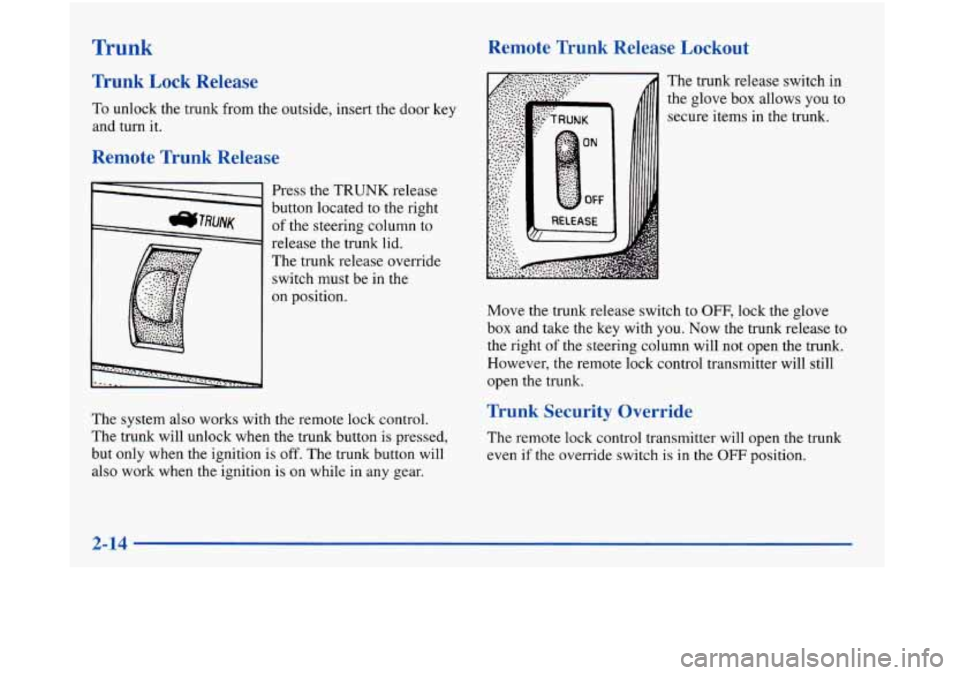
Trunk
Trunk Lock Release
To unlock the trunk from the outside, insert the door key
and turn it.
Remote Trunk Release
Press the TRUNK release
button located
to the right
of the steering column to
release the trunk lid.
The trunk release override
switch must be in the
on position.
The system also works with the remote lock control.
The trunk will unlock when the trunk button is pressed,
but only when the ignition is off. The trunk button will
also work when the ignition
is on while in any gear.
Remote Trunk Release Lockout
The trunk release switch in
the glove
box allows you to
secure items in the trunk.
Move the trunk release switch to
OFF, lock the glove
box and take the key with you. Now the trunk release to
the right of the steering column will not open the trunk.
However, the remote lock control transmitter will still
open the trunk.
Trunk Security Override
The remote lock control transmitter will open the trunk
even
if the override switch is in the OFF position.
2-14
Page 81 of 380
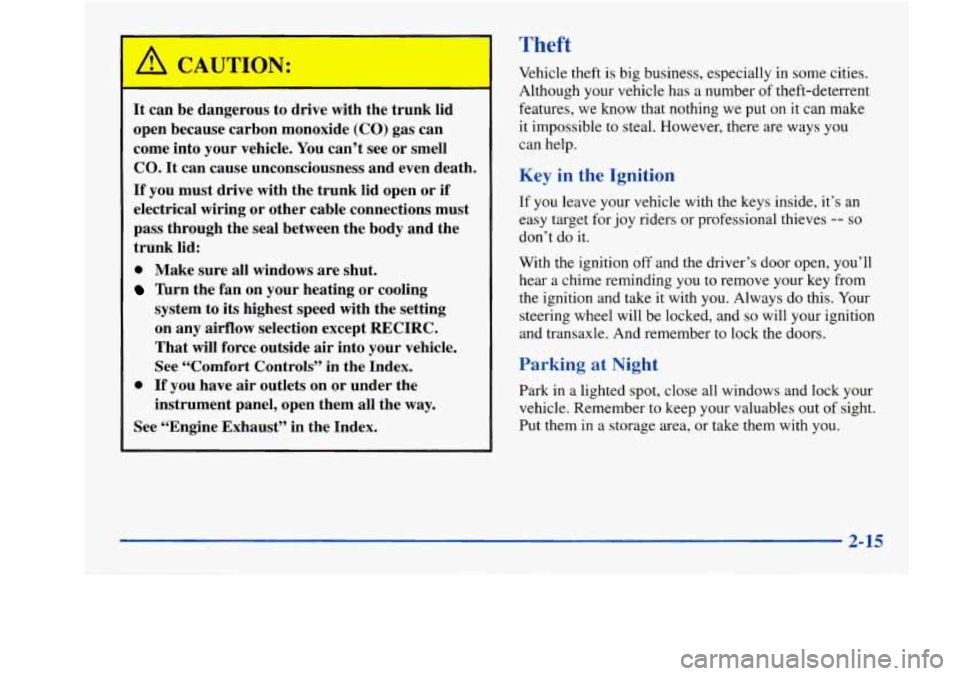
A CAUTION:
It can be dangerous to drive with the trunk lid
open because carbon monoxide
(CO) gas can
come into your vehicle. You can’t see
or smell
CO. It can cause unconsciousness and even death.
If you must drive with the trunk lid open or if
electrical wiring or other cable connections must
pass through the seal between the body and the
trunk lid:
0 Make sure all windows are shut.
Turn the fan on your heating or cooling
system to its highest speed with the setting
on
any airflow selection except RECIRC.
That will force outside air into your vehicle.
See “Comfort Controls” in the Index.
instrument panel, open them all the
way.
0 If you have air outlets on or under the
See “Engine Exhaust” in the Index.
Theft
Vehicle theft is big business, especially in some cities.
Although your vehicle has a number of theft-deterrent
features, we know that nothing we put on it
can make
it impossible
to steal. However, there are ways you
can help.
Key in the Ignition
If you leave your vehicle with the keys inside, it’s an
easy target for joy riders or professional thieves
-- so
don’t do it.
With the ignition off and the driver’s door open, you’ll
hear a chime reminding you to remove your key from
the ignition and take
it with you. Always do this. Your
steering wheel will be locked, and
so will your ignition
and transaxle. And remember to lock the doors.
Parking at Night
Park in a lighted spot, close all windows and lock your
vehicle. Remember to keep your valuables out
of sight.
Put them in a storage area, or take them with you.
2-15
Page 86 of 380
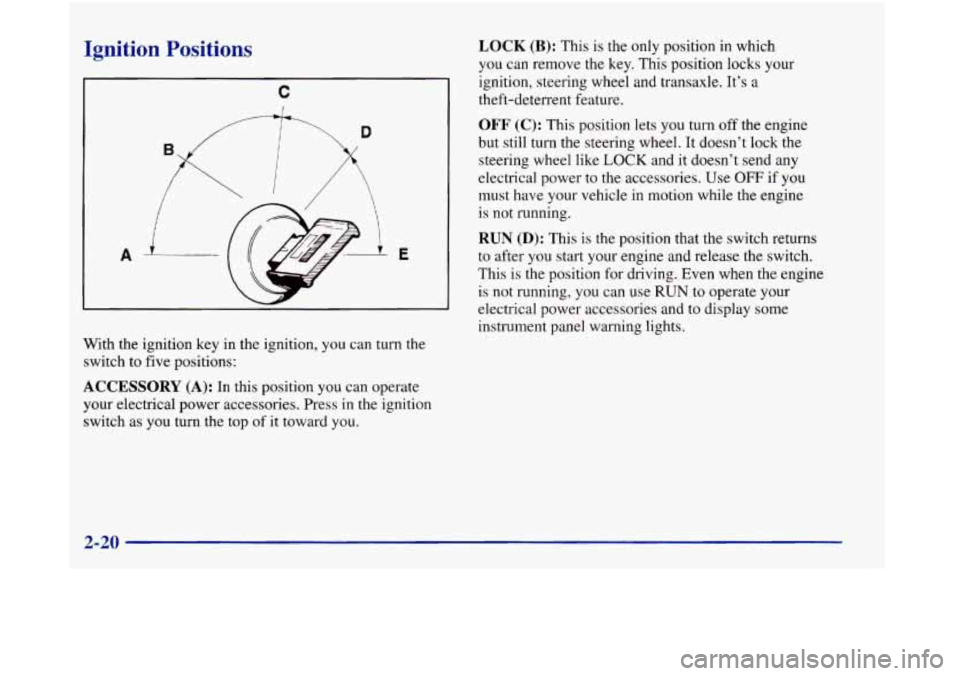
Ignition Positions
C
I
A E
With the ignition key in the ignition, you can turn the
switch to five positions:
ACCESSORY (A): In this position you can operate
your electrical power accessories. Press in the ignition
switch as you turn the top
of it toward you.
LOCK (B): This is the only position in which
you can remove the
key. This position locks your
ignition, steering wheel and transaxle. It’s a
theft-deterrent feature.
OFF (C): This position lets you turn off the engine
but still turn the steering wheel. It doesn’t lock the steering wheel like
LOCK and it doesn’t send any
electrical power
to the accessories. Use OFF if you
must have your vehicle in motion while the engine
is not running.
RUN (D): This is the position that the switch returns
to after you start your engine and release the switch.
This
is the position for driving. Even when the engine
is not running, you can
use RUN to operate your
electrical power accessories and to display some
instrument panel warning lights.
Page 87 of 380
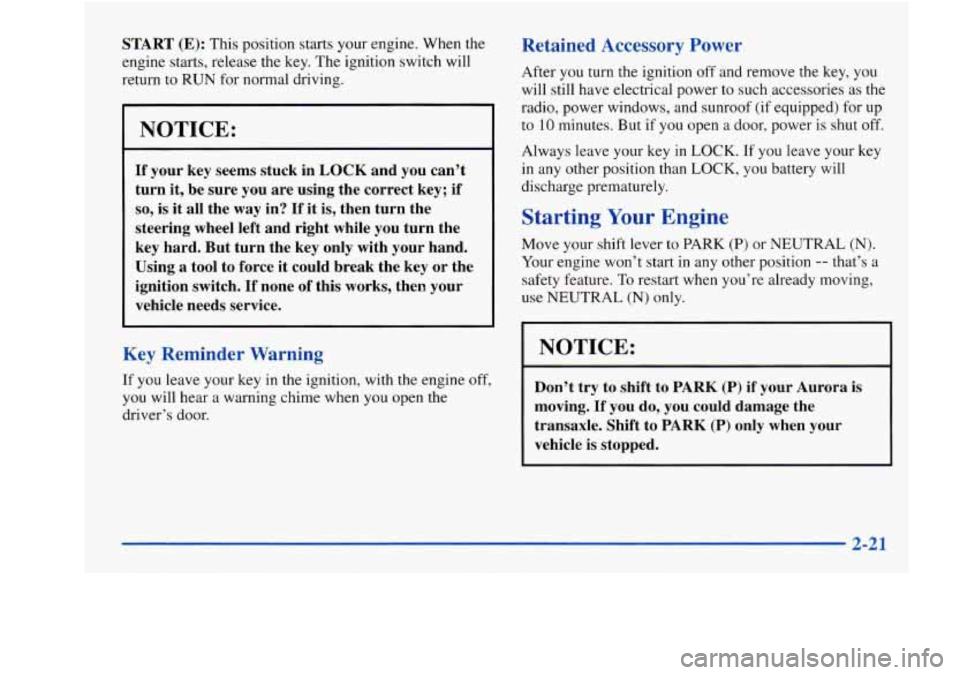
START (E): This position starts your engine. When the
engine starts, release the key. The ignition switch will
return to
RUN for normal driving.
FNOTICE:
If your key seems stuck in LOCK and you can’t
turn
it, be sure you are using the correct key; if
so, is it all the way in? If it is, then turn the
steering wheel left and right while you turn the
key hard. But turn the key only with your hand.
Using
a tool to force it could break the key or the
ignition switch.
If none of this works, then your
vehicle needs service.
Key Reminder Warning
If you leave your key in the ignition, with the engine off,
you will hear a warning chime when you open the
driver’s door.
Retained Accessory Power
After you turn the ignition off and remove the key, you
will still have electrical power to such accessories
as the
radio, power windows, and sunroof (if equipped) for up
to
10 minutes. But if you open a door, power is shut off.
Always leave your key in
LOCK. If you leave your key
in any other position than
LOCK, you battery will
discharge prematurely.
Starting Your Engine
Move your shift lever to PARK (P) or NEUTRAL (N).
Your engine won’t start in any other position -- that’s a
safety feature.
To restart when you’re already moving,
use NEUTRAL
(N) only.
NOTICE:
~ ~ ~~
Don’t try to shift to PARK (P) if your Aurora is I
moving. If you do, you could damage the
transaxle. Shift to PARK
(P) only when your
vehicle is stopped.
Page 98 of 380
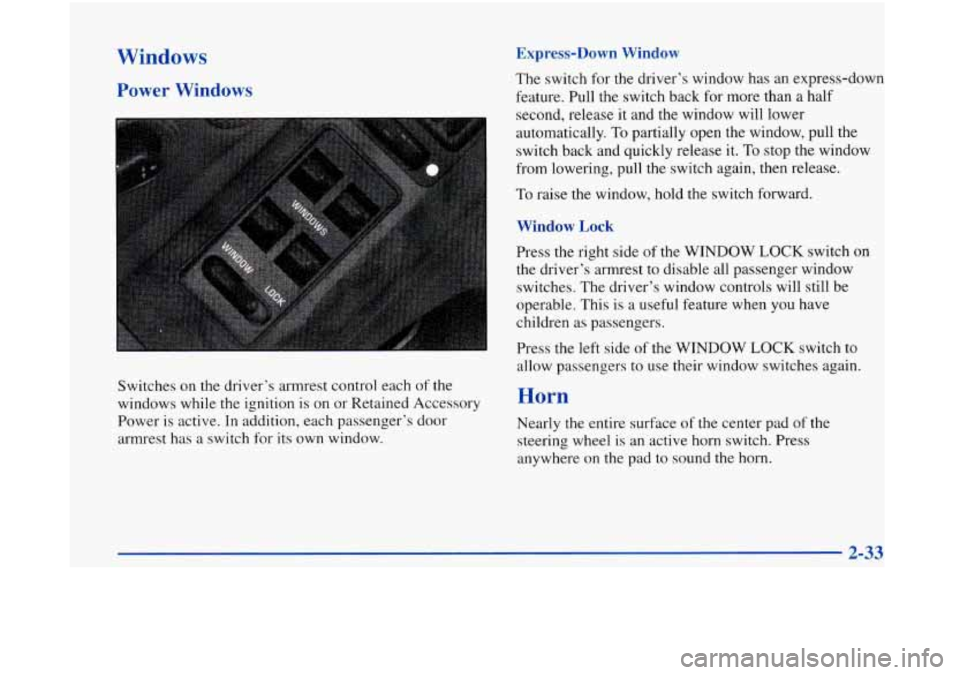
Windows
Power Windows
Switches on the driver’s armrest control each of the
windows while the ignition is on or Retained Accessory
Power is active. In addition, each passenger’s door
armrest has
a switch for its own window.
Express-Down Window
The switch for the driver’s window has an express-down
feature. Pull the switch back for more than a half
second, release it and the window will lower
automatically. To partially open the window, pull the
switch back and quickly release it.
To stop the window
from lowering, pull the switch again, then release.
To raise the window, hold the switch forward.
Window Lock
Press the right side of the WINDOW LOCK switch on
the driver’s armrest to disable all passenger window
switches. The driver’s window controls will still be
operable. This
is a useful feature when you have
children as passengers.
Press the left side of the WINDOW
LOCK switch to
allow passengers to use their window switches again.
Horn
Nearly the entire surface of the center pad of the
steering wheel is an active horn switch. Press
anywhere on the pad to sound the horn.
Page 100 of 380
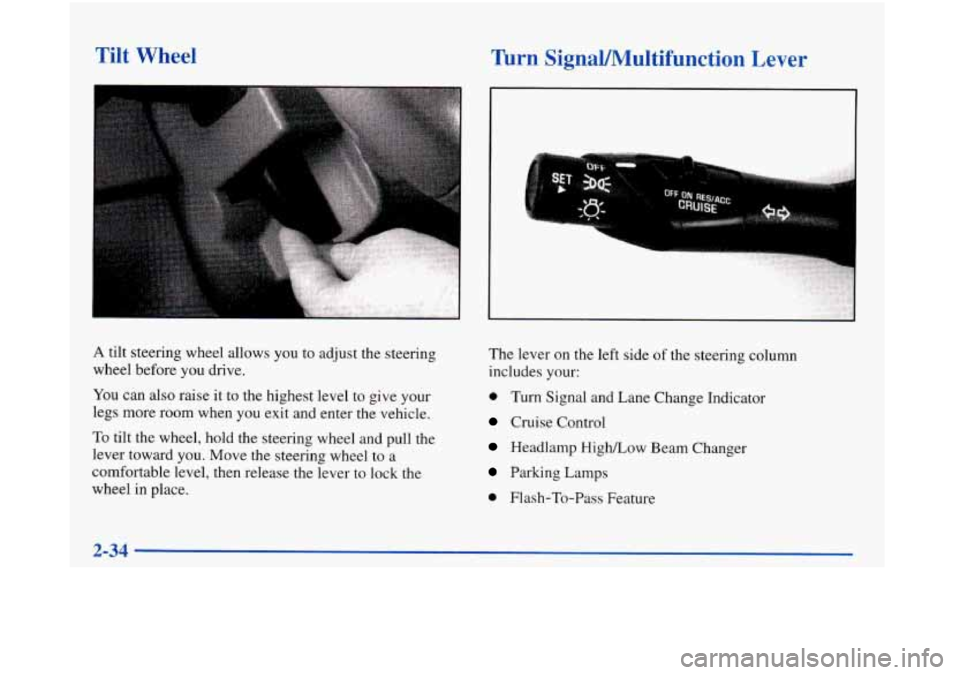
Tilt Wheel Turn SignaVMultifunction Lever
.. ::..,". .: ..:. s;r:
A tilt steering wheel allows you to adjust the steering
wheel before you drive.
You can also raise it to the highest level to give your
legs more room when you exit and enter the vehicle.
To tilt the wheel, hold the steering wheel and pull the
lever toward you. Move the steering wheel to a
comfortable level, then release the lever
to lock the
wheel in place. The
lever on the left side
of the steering column
includes your:
0 Turn Signal and Lane Change Indicator
Cruise Control
Headlamp High/Low Beam Changer
Parking Lamps
0 Flash-To-Pass Feature
2-34